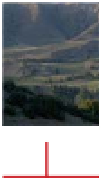Geology Reference
In-Depth Information
would have resulted if no bending
had taken place is smoothed out.
In some cases, normal faults, as
they descend into lower levels of the
crust, may become curved; such faults
are termed
listric faults
and may even
become sub-horizontal, allowing the
fault blocks above them to rotate and
slide over the basal fault, which acts as a
detachment horizon (Figure 5.4C). This
allows much larger extensions to take
place. Figure 5.4D shows how stretch-
ing of the crust by means of a low-angle
normal fault may ultimately lead to the
rise of the mantle to the surface and the
creation of an ocean basin. As the struc-
ture evolves, the original detachment
fault becomes inoperative in the foot-
wall and further extension takes place
along steeper 'successor' normal faults.
A
hangingwall s ynform
5
tilted block
34
35
B
C
Extensional faulting in petroleum
exploration
Many of the world's oil and gas fields
are hosted in structural traps created
by extensional faulting (e.g. Figure
5.5B), and much of the present-day
petroleum exploration has focused
on the mapping by remote means
of under-sea extensional structures.
Such structures are typical of exten-
sional basins and passive continental
margins (e.g. the North Sea and the
Atlantic margin west of Shetland,
where exploration activity in the
UK is currently concentrated). Our
detailed knowledge of extensional
faulting is largely due to interpreta-
tive
seismic sections
produced in the
course of petroleum exploration.
Figure 5.5A shows a typical example
from the western North Sea basin of the
structural and stratigraphic information
that can be obtained by this method.
petroleum
deposit
petroleum
deposit
impermeable
layers
cap
rock
cap
rocks
reservoir
rock
reservoir
rock
unconformity
source
rock
source
rock
f
ault
Figure 5.5
A.
Seismic section from the inner Moray Firth: an example to demonstrate the use of
reflection seismic prospecting to investigate submarine structure. The reflecting horizons (shown
in pink) are identified from borehole and other geological data and show an extensional fault array
affecting Jurassic strata (coloured in blue) overlain unconformably by basal Upper Cretaceous
(green); the faults were initiated during the Jurassic but activity continued into the Cretaceous; note
that the extension has resulted in the rotation and development of a synform in the hangingwall
and that the basal Cretaceous strata onlap the pre-Cretaceous surface, indicating a contemporary
slope up to the right. The vertical scale is in two-way travel time (TWT) for the seismic waves. Image
courtesy of Virtual Seismic Atlas, Rob Butler.
B, C.
Types of structural petroleum traps
The North Sea basin is dominated by
a series of grabens developed during
the Triassic to Jurassic period and the
petroleum deposits, which mostly
originate in Jurassic shales, are trapped
in the overlying sandstone formations
and capped by impervious rocks such
as the Upper Cretaceous Chalk Forma-
tion (Figure 5.5B, C). Determining the
detailed geometry of the structural
traps is therefore critical in finding
and exploiting petroleum reserves.

























Search WWH ::

Custom Search